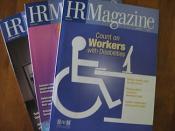Human Resource Planning is a term used by a business used to refer to their HR department's attempts to ensuring that they have the right numbers and types of people available to apply the right skills needed to realise the organisations' strategic business plan. It is "a strategy for ensuring that the organisations human resources will be capable of fulfilling the stated business mission" (Roberts & Wolf, 1983). In the latter part of the 20th century managers began planning human resources and not just capital, machinery etc. The idea of manpower planning became very popular. This focused on the supplies of personnel and did this through examining the movements through organisations and through certain jobs. But this did little good for the forecasting of labour. Managers soon began to dedicate more time to the human side of their enterprises. Manpower planning soon became replaced with Human Resource Planning (HRP). This would provide an approach to forecasting personnel supplies and demands as well as personnel initiatives to help meet organisational needs.
HRP involves a very large amount of uncertainty. It is not an exact science and for that reason mistakes are bound to occur. HRP can however help organisations to foresee changes and identify any trends in staffing resources, and to adopt personnel policies which help to avoid major problems. An effective human resource plan is the bases for a personnel management programme that helps reconcile differences between supply and demand. A framework can then be provided to help deal with any possible staffing difficulties that face an organisation. HR planning is a continuous process which seeks to ensure flexible resourcing related to internal and external environmental influences (Laurie J. Williams, Management & Organisational Behaviour 1999). Any possible future difficulties and problems can be anticipated through HRP. When used in co-ordination with consultation and participation of staff and unions, HRP help avoid harmful effects to individual members of staff or to the performance of the organisation.
In order for a company to function at peak efficiency they can't leave the attraction of human resources to chance. HRP involves assessing trends, forecasting supply and demand of labour and then developing appropriate strategies for addressing any differences (Management, Griffin 2002).
A survey of almost 100 business organisations in the UK looked in detail at the steps taken to overcome human resource problems (William Mercer Frazer Ltd. Manpower Planning Survey report, 1989). Almost 60% of the organisations undertook formal HR planning and a further 10% were considering its introduction. Some of the most important issues were identified as succession, planning, recruitment problems, and retention difficulties. Out of all the reports findings though, the one most obvious was the need for greater priority to be given HR planning because people are becoming central to organisations corporate plans. This means that organisations must change to make the best use of available skills while also developing human resource policies that are specifically aimed at maintaining competitiveness in the labour market.
HR planning is very important to an organisation as it allows the firm to know about job content and job requirements in order to develop appropriate selection methods and job-relevant performance appraisal systems and to set them necessary bonuses etc. This is done through a process known as Job Analysis. This is made up of two parts, the Description of the job and the Specification of the job. The description lists the duties of a job, the working conditions, tools, materials and equipment used to do the job. The specification lists the skills, abilities and credentials needed for the job.
Following management's understanding of the jobs within the organisation, they can then begin to plan for any future personnel needs of the company. This is usually done using a process similar to that shown in the diagram 1.0 below. The manager assesses any trends in past human resources, any future plans, and any general economic trends that are relevant. Then historical records can be used to predict any demand for employees. At the highest level of the organisation, management must plan for specific people and positions. Often good HR planners will have a record of who occupies what position, how long they are expected to stay there and who is, or will soon be, qualified enough to move into their position. These techniques help ensure no staffing shortages occur and also ensure that any loss of top personnel within the company is dealt quickly enough to ensure it doesn't become a problem for the company. The forecasting of the external supply of labour works somewhat differently however. To get an effective idea on the future supply of labour outside agencies information must be used such as government reports, employment commissions as well as student graduates with relevant qualifications.
Diagram 1.0 (Management, Griffin, 2002)
HR planning helps managers and organisations overcome any staffing shortages or even overstaffing. If a shortfall is expected then new employees can be hired, current staff can be moved to fill vacancies, retiring staff could be convinced to stay on or labour saving systems and technology can be introduced. If the human resource department feels the organisation is overstaffed, they can then transfer employees, not replace staff leaving the organisation or encourage early retirement. HRP is essential to the organisation because understaffing means that the company is not operating as best it could. The organisation can therefore expect loss of revenue, negative customer response and possible discontent among current staff. Overstaffing is an extremely expensive problem for companies. It also leads to a drop in efficiency and productivity. HR planning is used to help organisations avoid these problems and improve the company.
Recruiting employees is a very important part of an organisations success, some would say it's the most important as it is where the staff that will bring success either join the company or they don't. HR planning is used to get an idea of future human resource needs and then to complete the recruiting of new employees. HR must decide on internal recruiting, hiring present employees to fill vacancies, or external recruiting, and hiring persons from outside the organisation to fill vacancies. As unemployment continues to fall in Ireland, HR departments in companies have a tougher time recruiting employees. Hiring the wrong employee, in particular managers, can cost a large amount of money in both productivity and training. HR planning is used to manage the recruiting process within an organisation and is therefore crucial to the constant success and development of the firm.
Another benefit that HR planning brings to an organisation is a reduction in staff turnover. Staff turnover is usually a product of poor recruitment and selection, which is an area already mentioned as being helped by HRP. Staff turnover not only creates an increase in direct costs due to the fact that new staff has to be trained, it also disrupts the use of a manager's time. Added to these are the effects on staff morale, motivation and job satisfaction as well as possible effects with customers and suppliers. HR planning helps to attempt to select the best available staff and the best ways to retain them for a reasonable length of time. Therefore the HR manager must know several key points. They must know about the job being filled, the type of person needed to fill it, means of attracting the best and most suitable candidates, assessing candidate suitability as well as a good induction programme to introduce the person to the firm.
In an attempt to show if HRP is actually beneficial to an organisation, a study was undertaken to obtain a conclusive answer. Misa and Stein (1983) prepared a list of companies who were recognised for their productivity improvement. They compared these to a similar list of companies form the Fortune 500. In their conclusion they found that the productivity leaders, who had managed and planned their human resources, outperformed the compared firms on the basis of return on capital, return on equity, and net profit margin. This is one of the only current conclusive pieces of research that shows the improvements and benefits a company can expect through HRP.
The focus of HRP has begun to change in recent times. While forecasting demand and supply of labour has been the "heart of HRP" (Walker, 1980), most firms previously only engaged forecasting HR demand and paid very little attention to forecasting supply. But as firms encounter more and more competitors within their markets as well as the reduction in available labour due to decreased unemployment, they have had to give the process of forecasting the supply of labour more consideration. Forecasting supply will help keep an organisation ahead of it competitors and ensure long term staffing stability.
With the opening of trade barriers, expansion of the EU, development of China's economy, companies now face an unprecedented level of competition. Organisations are constantly looking for ways to achieve competitive edge. Improvements in supply chains and cost cutting have been effective for companies but one key way to achieve this advantage is through the harnessing and development of human resources. There is now a greater recognition that distinctive competencies are obtained through highly developed employee skills, distinctive organisational cultures, management processes and systems. This is in contrast to the traditional emphasis on transferable resources such as equipment. Increasingly it is being recognized that competitive advantage can be obtained with a high quality workforce that enables organizations to compete on the basis of market responsiveness, product and service quality, differentiated products and technological innovation.
Detailed and accurate Human Resource Planning is vital to an effective and organised company in any industry. Planning is the very heart of management as it helps owners and managers to reduce the uncertainty of the future, cope with change or improve upon current procedures. HRP can help to allow the employer to define objectives, control these objectives, and can lead to better employee performance and satisfaction. With effective planning a reduction in the likelihood of work disruptions can be expected as well as avoiding having inadequate labour during busy times. Likewise, paying careful attention to how and whom an organisation hires and retains can greatly increase the company's efficiency, while reducing the number of employees needed and in turn reduce overall costs for labour while increasing product quality which is essential for modern organisations as they strive to improve or maintain profit margins.
HR planning can help to reduce the hidden costs incurred within a business such as high turnover and wasted training time on the job, damaged equipment from an inexperienced worker operating unfamiliar equipment, and lost output due to poor worker performance. A planned process for hiring and managing labour helps lead to long-term success for an organisation. It is also possible that through HRP employee productivity can be increased and technological advancements can allow a company to reduce costs and time by employing fewer and more skilled and motivated workers.
It has been seen in Ireland, the UK and further a field that attempts reduce costs will inevitably lead to lay-offs, examples being Ford in the US or Irish Ferries here in Ireland. HR managers must then decide how is the workforce to be cut painlessly, while at the same time protecting the long-term interests of the organisation? HRP can be used to consider some of the following points:
The sort of workforce envisaged at the end of the exercise
The pros and cons of the different routes to get there
How the nature and extent of wastage will change during the run-down
The utility of retraining, redeployment and transfers
What the appropriate recruitment levels might be
Source: (www.employment-studies.co.uk)
If these points can be analysed within an organisation, they can be presented to senior managers who in turn can assess the cost benefit of various methods, and the time taken to meet targets can then be established. Without HR planning's involvement in redundancies there is a danger that an unbalanced workforce will result, reflecting the take-up of the severance offer. It is often difficult and expensive to replace lost quality and experience.
Conclusion:
Human Resource Planning has emerged as a very popular concept among organisations in recent years and appears that more and more companies are turning to HRP to further their survival and success in the modern business world. Clearly HRP has many benefits to an organisation from reducing labour costs to meeting labour demands while also increasing a company's competitiveness. With more and more people training and studying within the area of HRP, it is clear there is a demand from organisations to have planners within their human resource department.
The planning of the Human Resource function has a substantial effect on the bottom-line performance of a firm. Poor HR planning leads to hiring in "spurts" followed soon by a series of lay-offs. With the Human Resource function so closely linked to the overall business plan of an organisation, effective planning of this function is a crucial element of success and it why Human Resource Planning has become such an essential activity for most businesses.


